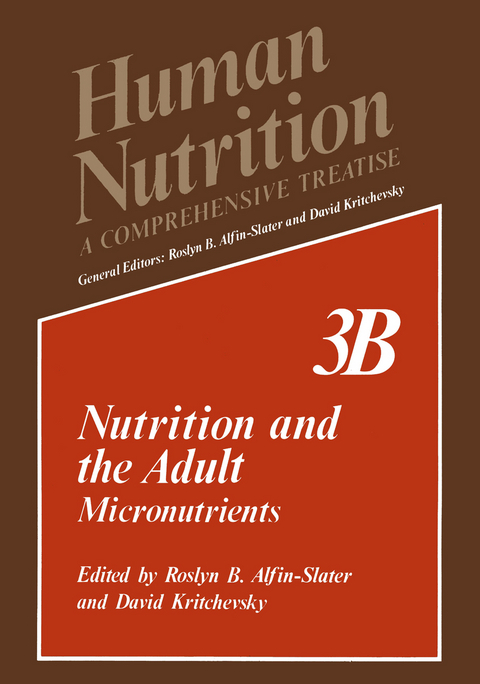
Nutrition and the Adult
Springer-Verlag New York Inc.
978-1-4615-7218-3 (ISBN)
1 Roles of Vitamins as Coenzymes.- 1. Introduction.- 2. Biotin.- 3. Nicotinic Acid.- 4. Pantothenic Acid.- 5. Vitamin B6.- 6. Thiamine.- 7. Lipoic Acid.- 8. Folic Acid.- 9. Vitamin B12.- 10. Riboflavin.- 11. Coenzyme Q.- 12. Other Vitamin Cofactors.- 13. References.- 2 Vitamin C.- 1. The Lure of Vitamin C.- 2. Discovery of Vitamin C.- 3. Biochemistry and Physiology.- 4. Metabolic Functions of Vitamin C.- 5. Minimal Daily Requirement and Recommended Allowance.- 6. Scurvy in Experimental Animals.- 7. Clinical Scurvy.- 8. Human Scurvy.- 9. Food Sources of Vitamin C.- 10. Pharmacologic Doses.- 11. Toxicity of Vitamin C.- 12. Summary.- 13. References.- 3 Vitamin A.- 1. Historical Introduction.- 2. Nomenclature, Chemical Structures, and Chemical Properties.- 3. Absorption.- 4. Storage.- 5. Transport of Vitamin A.- 6. Vitamin A Deficiency and the Function of Vitamin A.- 7. Biochemical Mechanisms of Vitamin A Function.- 8. The Metabolism of Vitamin A.- 9. The Retinoids.- 10. Hypervitaminosis Aand Vitamin A Toxicity.- 11. Vitamin A Pharmacology.- 12. References.- 4 Vitamin D.- 1. Introduction.- 2. History.- 3. Deficiency Diseases.- 4. The D Vitamins and Their Precursors.- 5. Metabolism of Vitamin D.- 6. Regulation of Vitamin D Metabolism.- 7. The Interaction between Vitamin D and Parathyroid Hormone.- 8. Regulation of the Renal Vitamin D Hydroxylases by the Sex Hormones.- 9. Mechanism of Vitamin D Action.- 10. Diseases of Bone as a Consequence of Defects in Vitamin D Metabolism.- 11. Vitamin D Toxicity.- 12. Conclusion.- 13. References.- 5 Vitamin E.- 1. History.- 2. Chemistry and Nomenclature.- 3. Deficiency Symptoms.- 4. Biopotency.- 5. Food Sources.- 6. Metabolism.- 7. Biochemical Function.- 8. Nutritional Role.- 9. Pharmacological Effects.- 10. Safety.- 11. References.- 6 Vitamin K.- 1. Introduction.- 2. Early History.- 3. Chemistry of the K Vitamins.- 4. Nomenclature.- 5. Principles of the Determination of Vitamin(s) K.- 6. Vitamin K Content of Foods.- 7. Absorption, Distribution, and Metabolism of Vitamin K.- 8. Physiological Function of Vitamin K.- 9. Bone and Kidney Proteins Containing ?-Carboxyglutamate.- 10. Coumarin Anticoagulant Drugs.- 11. Vitamin K Deficiency.- 12. Nutritional Requirements for Vitamin K.- 13. References.- 7 Iron—Hemoglobin.- 1. Introduction.- 2. Iron Balance.- 3. Distribution and Function of Body Iron.- 4. Iron Losses.- 5. Assessment of Iron Status.- 6. Iron Absorption.- 7. Pathology of Iron Deficiency and Anemia.- 8. Iron Requirements—Dietary Iron.- 9. Conclusion.- 10. References.- 8 Trace Elements.- 1. Introduction.- 2. Calcium.- 3. Phosphorus.- 4. Magnesium.- 5. Sodium and Potassium.- 6. Iron.- 7. Zinc.- 8. Copper.- 9. Selenium.- 10. Cobalt.- 11. Silicon.- 12. Chromium.- 13. Vanadium.- 14. Nickel.- 15. Manganese.- 16. Fluoride.- 17. Tin.- 18. Conclusion.- 19. References.- 9 Drug—Nutrient Interrelationships.- 1. Introduction.- 2. The Effects of Drugs on Nutritional Status.- 3. The Effects of Nutritional Status on Drug Metabolism.- 4. Summation.- 5. References.- 10 Oral Contraceptives and Nutrient Requirements.- 1. Introduction.- 2. Effect of OCs on Nutrient Metabolism and Requirements.- 3. Conclusion.- 4. References.- 11 Nutrition of the Elderly.- 1. Introduction.- 2. Changes Associated with Aging.- 3. Influence of Nutrition on Longevity.- 4. Nutrient Requirements of the Elderly.- 5. Assessment of Nutritional Status of the Elderly.- 6. Nutrition-Related Diseases of the Elderly.- 7. Food Attitudes, Beliefs, and Practices of the Elderly.- 8. References.
| Reihe/Serie | Human Nutrition ; 3B |
|---|---|
| Zusatzinfo | 2 Illustrations, color; 8 Illustrations, black and white; XIX, 424 p. 10 illus., 2 illus. in color. |
| Verlagsort | New York, NY |
| Sprache | englisch |
| Maße | 178 x 254 mm |
| Themenwelt | Medizin / Pharmazie ► Gesundheitsfachberufe ► Diätassistenz / Ernährungsberatung |
| Naturwissenschaften ► Biologie ► Biochemie | |
| ISBN-10 | 1-4615-7218-5 / 1461572185 |
| ISBN-13 | 978-1-4615-7218-3 / 9781461572183 |
| Zustand | Neuware |
| Haben Sie eine Frage zum Produkt? |
aus dem Bereich


